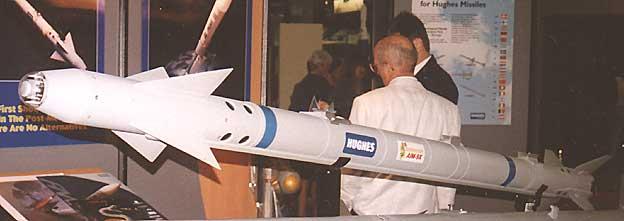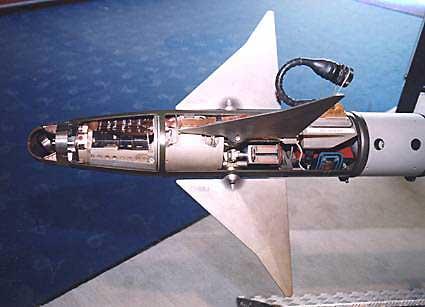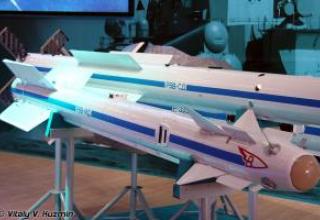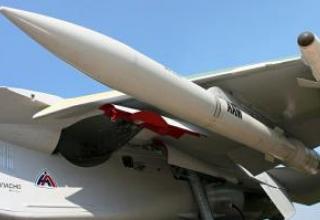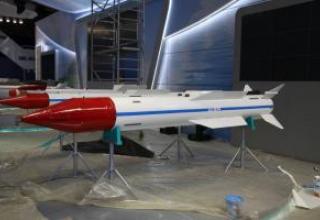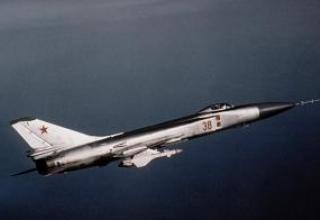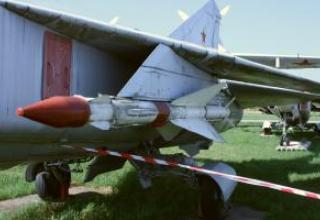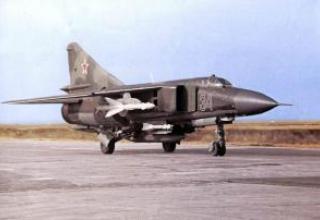In the U.S. since 1996, Raytheon has been fully developing the Air-to-Air Short Range Guided Missile (AIM-9X), which is designed to engage air targets in close maneuverable air combat day and night. It is planned to replace the F/A-18C/D/E/F, F-15C/E, F-16C/D, F-22 U.S. tactical aircraft in service with AIM-9M "Sidewinder" missile of this class.
The need to develop such a missile due to new requirements, and the requirements for this type of weapon, the main of which are to ensure the ability to launch the UR on the target located on a large (up to 90 °) angular deviations from the course of the aircraft carrier, the defeat of cruise missiles, increased selectivity and interference immunity of the guidance system.
In addition, the increased work on this missile is due to the lack of combat effectiveness of U.S. tactical fighters in close air combat. This conclusion was made by foreign experts, analyzing the results of air battles of the U.S. F-16 aircraft, equipped with Sidewinder, with MiG-29 fighters of the German Air Force, armed with R-73 missiles paired with a helmet-mounted target designation system. As a rule, they ended in a conditional victory of the MiG-29, despite the fact that, as noted by experts, their pilots had to spend more time preparing missiles for launch and monitor the value of overload aircraft (on the F-16, these operations are carried out automatically). According to U.S. experts, the main advantage of aircraft missile intercept systems of Russian development is the high maneuverability of missiles, their ability to be guided to the target at an angular deviation from the course of the aircraft-carrier to 60 ° and the use of helmet-mounted target designation system.
Composition:
The AIM-9X missile, built according to the normal aerodynamic scheme, is equipped with a titanium cruciform wing and movable plumage integrated with a gas-dynamic rudder block.
In the AIM-9X used with some adaptation of the units and assemblies of the previous modification of the AIM-9M.
The core combat unit (WAU-17/B) with titanium hitting elements is equipped with an upgraded safety executive mechanism (PIM) located in the central chamber of the BC. The PIM platoon takes place after three conditions have been met - receiving a command to launch a missile, a signal from an axial overload sensor and reaching a safe distance from the aircraft carrier. The BC is detonated by initiating pulses from the fuse simultaneously on both ends of the explosive charge.
The active laser non-contact fuse is a modified DSU-15A/A or DSU-15B/B fuse of missile AIM-9M and is designated DSU-36 and DSU-37 respectively. Its main elements are the transmitting and receiving parts. The laser energy is emitted through the four front windows by a diode made on the gallium arsenide, and the signals reflected from the target are received by a silicon photodiode, through four windows located in the tail of the missile. The non-contact fuse ensures that the BC is detonated at an optimal distance from the target.
The Mk139 solid propellant rocket engine (see photo) of the AIM-9X missile is similar to the Mk36 Mod 11 AIM-9M engine and consists of an X-61 (AS 6065) hull, blended fuel charge and launch device. The casing is made of structural steel 4130. The main ignition charge is the granular potassium boron/nitrate system (BKNO3). Nozzle body is made of 17-4 PH stainless steel with heat protection from phenolic resin based composite material with silicon oxide filler.
The engine is additionally equipped with a traction vector control system (CVT) with four gas-dynamic rudders located in the nozzle output section, as well as a control connector in the central part. Gas-dynamic rudders of SHVT are mechanically connected with aerodynamic rudders in the tail part of the rocket. Prior to the launch of the missile, the SIVT tail aerodynamic and gas dynamic rudders are locked. When the rocket's power supply system is activated, the rudders are unlocked and the rocket's hydraulic system is fed. After the successful passing of the rudder mobility test, the possibility of sending a command to start the marching engine is also unlocked. The placement of the SHUT in the tail of the missile forced the developers to abandon the use of a recessed nozzle, which was used on previous modifications of the missile "Sidewinder".
AIM-9X has a new combined control system, the main elements of which are:
- All-view thermal imaging CNS with IR detector matrix located in the focal plane of the optical system with the size of 128 x 128 elements,
- Inertial Management System (IMS),
- contact fuse,
- two thermobatteries,
- Small-sized autonomous cryogenic plant, designed to obtain the refrigerant, cooling the sensitive elements of the CNS, directly on the rocket itself.
The operation of the RBM guidance loop is performed in accordance with the proportional law of management. The AIM-9X control system is fully digital and can be self-tested and reprogrammed. The CLO fairing is made of a new material based on an artificial sapphire (aluminum oxide).
To ensure communication of the control system with other elements of the missile, a cable line covered with a special lightweight plastic fairing has been laid outside the casing. The central part of the cowling is made of aluminium - inside there is a unit of electronic devices of the control system.
In case of combat application, the SD can be launched after the GSN captures the target or without it, according to the target designation provided by the onboard sighting devices, including the pilot's helmet system developed specially for the AIM-9X SD application from Air Force and Navy tactical fighters and designated JHMCS (Joint Helmet Mounted Cueing System). The JHMCS (Joint Helmet Mounted Cueing System) allows the missile to be launched at target angles up to + 90° and is designed to make full use of the technical capabilities of the AIM-9X.
The infrared homing head has pumping angles of ± 90°, the range of target acquisition - 14... 18.5 km in free space and 7.4 km against the ground. Target grabbing in suspension under the carrier can be carried out according to the target designation from the radar or NSC, as well as by direct aiming or possible search of the ISG in the solid angle of ±40 ... 45°. Target trajectory capture (LOAL - "Lock-On After Launch") is ensured by target designation from the inertial system. In this mode, the inertial navigation system controls the missile based on the predicted target position and directs the CNS until the target is captured and moved to homing. The CNS provides target image recognition and identification based on predetermined features. Target acquisition on the trajectory is used: in long-range air combat outside the range of the CNS capture, when the missile is placed inside the fuselage (F-35), as well as in the conditions of the aircraft carrier in a unified information network. In the latter case, the AIM-9X can use remote designation data transmitted to the aircraft carrier through communication with other fighter groups and reconnaissance aircraft, ie act in accordance with the evolving concept of a centralized network technology to provide combat operations NCW ("Network-centric Warfare"). It is possible, for example, to launch a rocket into the rear hemisphere of a carrier aircraft ("over the shoulder").
The interface between the launch vehicle and the missile is provided via the front and middle connectors of the modified launcher LAU-7D/A or LAU-127A/A. Since the missile is equipped with an autonomous cryogenic unit, there is no need to place the refrigerant tanks and the corresponding fittings inside the PU.
Characteristics:
| Maximum firing range, km | 20 |
| Length, m | 2,9 |
| Diameter, m | 0,127 |
| Wingspan, m | 0,355 |
| Wheelspan, m | 0,445 |
| Range of fire, km | 20 |
| Start weight, kg | 85 |
| Weight of combat unit, kg | 9,4 |
| Marshal engine Mk139 | |
| Diameter, mm | 152 |
| Length, mm | 1981 |
| Cartridge weight, kg | 46 |
| Temperature operating mode | from -54°C to +63°C |
| Operation time | 10 years |
Testing:
Despite the declared high effectiveness of HARM missiles of early modifications can not be considered a modern high-precision weapon because they do not have a full-fledged recognition system "insider". Thus, for example, during Operation Desert Storm, the U.S. Air Force could not always effectively use HARM missiles because the Iraqi air defense facilities, along with Soviet-made systems (against which the use of this type of missiles is calculated) included American Hawk systems.
Sources:
- Системы управления вооружением истребителей: Основы интеллекта многофункционального самолета /РАРАН; Л.Е.Баханов и др.; под ред. Е.А.Федосова М.:Машиностроение, 2005.400с. (Справ.б-ка разработчика исследователя).
- К.Егоров "Перспективы развития зарубежных управляемых ракет класса "Воздух-воздух", Зарубежное военное обозрение. №5.2001
- AIM-9 Sidewinder
- The Sidewinder Story
- http://www.orbitalatk.com/defense-systems/missile-products/sidewinder/docs/AIM-9X_Sidewinder_Fact_Sheet_Approved_April_2015.pdf
